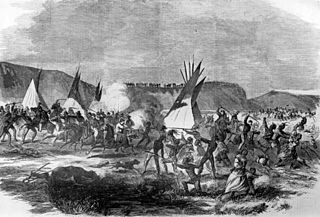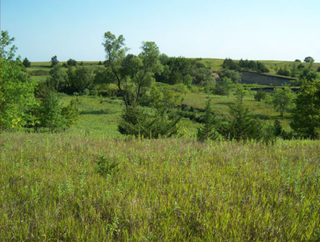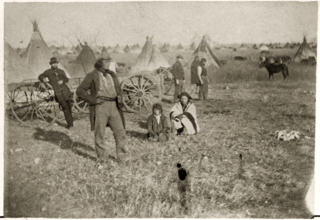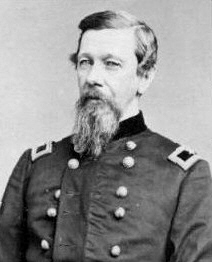Background
The defeat of Little Crow in the Dakota War of 1862 caused the widespread dispersion of the Santee Sioux or Eastern Dakota. More than 4,000 Santee and other Sioux congregated in the summer of 1863 in a large encampment in present-day Kidder County, North Dakota. [1]
In June and July 1863, Brigadier general Henry Hastings Sibley led a military expedition to punish the Santee. Sibley had 2,056 men – 1,436 infantry, 520 cavalry, and 100 artillery and white and Indian scouts. On July 24, Sibley found the Sioux camp and the Battle of Big Mound ensued. The Sioux retired from the battlefield, the warriors fighting a rear guard action to protect their families for about 12 miles (20 km). As the families continued to flee toward safety across the Missouri River, the warriors paused at Dead Buffalo Lake, about two miles (3 km) northwest of present-day Dawson, North Dakota to await Sibley's advance. [2]
Many of the Santee under their leader Standing Buffalo had been reluctant fighters and appear to have avoided further conflict by fleeing northwest and eventually to Canada, rather than halt at Dead Buffalo Lake. The remaining Santee, Yankton, and Yanktonai whose best known leader was Inkpaduta, were joined by about 650 Hunkpapa and Blackfoot (Lakota) Teton warriors. This brought the number of Indian warriors up to 1,600, according to one estimate. Sitting Bull was among the Teton reinforcements. [3]
Battle
Sibley marched to Dead Buffalo Lake on July 26 and about noon camped near the shores of the small lake. Mounted Sioux appeared shortly on the hills surrounding the lake and Sibley's camp, threatening an attack. Sibley advanced his artillery, two companies of infantry, and his pioneers to a position about 600 yards in advance of his camp and opened fire at long range on the Indians. The Indians withdrew to a safe distance. [4]
The objective of the Sioux seems to have been to capture the army's pack train of horses and mules and immobilize Sibley. They first attempted an assault on Sibley's left flank, but were checked by a company of mounted rangers and two companies of infantry. The Indians then disappeared into the hills. Several muleteers in Sibley's camp assumed the engagement was over and took the livestock out of the defense lines to graze. The Sioux re-appeared in force on the right flank and made another effort to capture the stock, but were repulsed in a brief close-quarter fight by two companies of cavalry and 6 companies of infantry. Sitting Bull, armed with only a whip, was said to have counted coup on a muleteer and captured his mule. Failing in their mission to capture most of the horses and mules, the Indians then retired from the field and the battle was over. [5]
One soldier was killed. The soldiers estimated they had killed 15 Sioux. [6] The number of Indian combatants and Indian casualties were often overestimated by the army.
The Lakota are a Native American people. Also known as the Teton Sioux, they are one of the three prominent subcultures of the Sioux people. Their current lands are in North and South Dakota. They speak Lakȟótiyapi—the Lakota language, the westernmost of three closely related languages that belong to the Siouan language family.

The Sioux or Oceti Sakowin are groups of Native American tribes and First Nations peoples in North America. The modern Sioux consist of two major divisions based on language divisions: the Dakota and Lakota; collectively they are known as the Očhéthi Šakówiŋ. The term "Sioux" is an exonym created from a French transcription of the Ojibwe term "Nadouessioux", and can refer to any ethnic group within the Great Sioux Nation or to any of the nation's many language dialects.

The Battle of Killdeer Mountain took place during Brig. Gen. Alfred Sully's expedition against the Sioux Indians in Dakota Territory July 28–29, 1864. The location of the battleground is in modern Dunn County, North Dakota. With a total of more than 4,000 soldiers involved, Sully's expedition was the largest ever carried out by the U.S. army against Indians.

The Sioux Wars were a series of conflicts between the United States and various subgroups of the Sioux people which occurred in the later half of the 19th century. The earliest conflict came in 1854 when a fight broke out at Fort Laramie in Wyoming, when Sioux warriors killed 31 American soldiers in the Grattan Massacre, and the final came in 1890 during the Ghost Dance War.
Nakota is the endonym used by those Assiniboine Indigenous people in the US, and by the Stoney People, in Canada.

The Battle of Big Mound was a United States Army victory in July 1863 over the Santee Sioux Indians allied with some Yankton, Yanktonai and Teton Sioux in Dakota Territory.

The Battle of Stony Lake was the third and last engagement of Henry Hastings Sibley's 1863 campaign against the Santee, Yankton, Yanktonai and Teton Sioux in Dakota Territory. Following the battle, the Indians fought delaying actions against Sibley until their women and children had successfully crossed the Missouri River. Sibley then gave up his chase of them.
The Mdewakanton or Mdewakantonwan are one of the sub-tribes of the Isanti (Santee) Dakota (Sioux). Their historic home is Mille Lacs Lake in central Minnesota. Together with the Wahpekute, they form the so-called Upper Council of the Dakota or Santee Sioux. Today their descendants are members of federally recognized tribes in Minnesota, South Dakota and Nebraska of the United States, and First Nations in Manitoba, Canada.

The Battle of Whitestone Hill was the culmination of the 1863 operations against the Sioux or Dakota people in Dakota Territory. Brigadier General Alfred Sully attacked a village September 3–5, 1863. The Native Americans in the village included Yanktonai, Santee, and Teton (Lakota) Sioux. Sully killed, wounded, or captured 300 to 400 Sioux, including women and children, at a cost of about 60 casualties. Sully would continue the conflict with another campaign in 1864.

The state of Iowa played a significant role during the American Civil War in providing food, supplies, troops and officers for the Union army.

Fort Abercrombie, in North Dakota, was an American fort established by authority of an act of Congress, March 3, 1857. The act allocated twenty-five square miles of land on the Red River of the North in Dakota Territory to be used for a military outpost, but the exact location was left to the discretion of Lieutenant Colonel John J. Abercrombie. The fort was constructed in the year 1858. It was the first permanent military settlement in what became North Dakota, and is thus known as "The Gateway to the Dakotas".

The Battle of Wood Lake occurred on September 23, 1862, and was the final battle in the Dakota War of 1862. The two-hour battle, which actually took place at nearby Lone Tree Lake, was a decisive victory for the U.S. forces led by Colonel Henry Hastings Sibley. With heavy casualties inflicted on the Dakota forces led by Chief Little Crow, the "hostile" Dakota warriors dispersed. Little Crow and 150 followers fled for the northern plains, while other Mdewakantons quietly joined the "friendly" Dakota camp started by the Sisseton and Wahpeton bands, which would soon become known as Camp Release.

The Battle of Birch Coulee occurred September 2–3, 1862 and resulted in the heaviest casualties suffered by U.S. forces during the Dakota War of 1862. The battle occurred after a group of Dakota warriors followed a U.S. burial expedition, including volunteer infantry, mounted guards and civilians, to an exposed plain where they were setting up camp. That night, 200 Dakota soldiers surrounded the camp and ambushed the Birch Coulee campsite in the early morning, commencing a siege that lasted for over 30 hours, until the arrival of reinforcements and artillery led by Colonel Henry Hastings Sibley.

The Surrender at Camp Release was the final act in the Dakota War of 1862. After the Battle of Wood Lake, Colonel Henry Hastings Sibley had considered pursuing the retreating Sioux, but he realized he did not have the resources for a vigorous pursuit. Furthermore, he was aware that Chief Little Crow had been losing support and was in contact with several Mdewakanton chiefs who had signaled their opposition to further conflict.

The Dakota War of 1862, also known as the Sioux Uprising, the Dakota Uprising, the Sioux Outbreak of 1862, the Dakota Conflict, the U.S.-Dakota War of 1862, or Little Crow's War, was an armed conflict between the United States and several bands of eastern Dakota also known as the Santee Sioux. It began on August 18, 1862, at the Lower Sioux Agency along the Minnesota River in southwest Minnesota.

The Dakota are a Native American tribe and First Nations band government in North America. They compose two of the three main subcultures of the Sioux people, and are typically divided into the Eastern Dakota and the Western Dakota.
The 1st Dakota Cavalry was a Union battalion of two companies raised in the Dakota Territory during the American Civil War. They were deployed along the frontier, primarily to protect the settlers during the Sioux Uprising of 1862.

The Battle of the Badlands was fought in Dakota Territory, in what is now western North Dakota, between the United States army led by General Alfred Sully and the Lakota, Yanktonai, and the Dakota Indian tribes. The battle was fought August 7–9, 1864 between what are now Medora and Sentinel Butte, North Dakota. It was an extension of the conflict begun in the Dakota War of 1862. Sully successfully marched through the badlands encountering only moderate resistance from the Sioux.
The Department of the Northwest was an U.S. Army Department created September 6, 1862 to put down the Sioux uprising in Minnesota. Major General John Pope was made commander of the Department. At the end of the Civil War the Department was redesignated the Department of Dakota. Immediately upon arriving in St. Paul General Pope sent letters to the Governors of Iowa and Wisconsin for additional troops to assist the 5th Minnesota Infantry Regiment. From Iowa he got the 27th Iowa Infantry Regiment and from Wisconsin he received the 25th Wisconsin Infantry Regiment. Both quickly crossed the border to assist with the uprising. The 25th Wisconsin was in Minnesota three months and the 27th Iowa was there a month before both headed south. After they departed, the Minnesota District would be garrisoned by Minnesota units: 5th, 6th, 7th, 8th, 9th, 10th Infantry Regiments, 1st and 2nd Minnesota Cavalry Regiments plus Minnesota Independent Cavalry Battalion as well as the 3rd Minnesota Light Artillery Battery. In 1864 companies of the 30th Wisconsin Infantry Regiment would see service in the Minnesota and Dakota Districts too.
This timeline of South Dakota is a list of events in the history of South Dakota by year.















